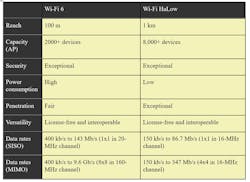What’s the Difference Between Wi-Fi 6 and Wi-Fi HaLow?
This article appeared in Microwaves & RF and has been published here with permission.
This article is part of the TechXchange: Wireless IoT Technologies.
Members can download this article in PDF format.
What you will learn:
- What is Wi-Fi 6?
- What is Wi-Fi HaLow?
- Why Wi-Fi HaLow is important to IoT applications.
As the number of Internet of Things (IoT) devices explodes (some projections put the total number of IoT devices at more than 40 billion by 2025), our expectations for fast, energy-efficient, and secure connectivity are also skyrocketing. This dramatic growth and demand for IoT devices is exposing gaps in our existing connectivity protocols that wireless technology innovators are racing to fill.
What is Wi-Fi CERTIFIED 6?
Wi-Fi 6 is the latest Wi-Fi technology for the 2.4-, 5-, and 6-GHz unlicensed and class-licensed bands, designated for products that incorporate the IEEE 802.11ax specification.1 Previous generations include Wi-Fi 4 (IEEE 802.11n) for the 2.4- and 5-GHz bands and Wi-Fi 5 (IEEE 802.11ac) for the 5-GHz band.
A Wi-Fi 6 device designed for the 2.4- and/or 5-GHz bands is also backward-compatible with the earlier Wi-Fi technologies including IEEE 802.11a, IEEE 802.11b, and IEEE 802.11g. That means it has additional overheads for packet transmission, including longer packet preambles and additional protection mechanisms.
According to the Wi-Fi Alliance, Wi-Fi 6 emphasizes “quality connectivity in locations with hundreds or thousands of connected devices such as stadiums and other public venues, as well as corporate networks utilizing time-sensitive, high bandwidth applications.” We’re talking capacity, efficiency, dense coverage, and the performance required by users today in busy environments. So, this is primarily for high-throughput, short-range applications in the 5- and 6-GHz bands, such as gaming and virtual reality.
What About Wi-Fi CERTIFIED HaLow?
Wi-Fi HaLow is the latest MAC/PHY protocol certified by the Wi-Fi Alliance.2 It was engineered specifically to meet the demands of the IoT, offering longer range and lower power connectivity than Wi-Fi 4, 5, or 6. Wi-Fi HaLow meets the unique requirements of challenging environments, enabling a variety of IoT use cases in industrial, agricultural, smart-building, and smart-city environments.
At a Glance: Wi-Fi HaLow vs. Wi-Fi 6
Not all Wi-Fi has been created equally, especially when we’re looking at IoT applications. The table provides a comparison of IEEE 802.11ah Wi-Fi HaLow with 802.11ax Wi-Fi 6, according to the most popular features sought by home and business owners.
Depth and Breadth of Connectivity
Wi-Fi HaLow operates in the sub-1-GHz band with relatively narrow channels, typically from 1 to 8 MHz in width, although 16-MHz channels are also specified in IEEE 802.11ah. Very-low-power IoT devices can make use of 1- or 2-MHz channels while long-range, low-power cameras with higher throughput requirements may take advantage of 4- and 8-MHz channels.
Narrow channels together with sub-1-GHz RF frequencies between 850 and 950 MHz and range-optimized modulation and coding scheme (MCS) rates enable Wi-Fi HaLow’s range to exceed 1 kilometer.3 That’s 10X the range of Wi-Fi 6 (≅100 meters). In addition, the sub-1-GHz signals used by Wi-Fi HaLow pass through walls and other obstacles more effectively than 2.4-, 5-, and 6-GHz Wi-Fi 6 signals, regardless of the obstacle’s construction material.
Wi-Fi 6 supports orthogonal frequency-division multiple access (OFDMA) with resource unit (RU) allocation to allow multiple clients to transmit or receive from an access point (AP) at the same time.4 Although this appears to provide narrower channels, the actual minimum channel width and sampling rate remains 20 MHz, which doesn’t provide the same power saving as the narrow channels used by Wi-Fi HaLow.
Understanding AP Capacity
A single Wi-Fi HaLow AP can handle up to 8,191 devices, which is 4X the capacity supported by a Wi-Fi 6 AP (2,007 devices). That’s significantly more LED bulbs, smart door locks, and security cameras, not to mention the vast number of automation devices employed by smart buildings and factories.
In a smart-home setting, Wi-Fi 6 routers generally support tens of devices, while a single Wi-Fi HaLow AP installed in a home by a broadband service provider can easily scale to meet the IoT demands of any household.
Security in Play
Wi-Fi HaLow and Wi-Fi 6 both incorporate IEEE 802.11 protocols, which means they adhere to a globally recognized standard that defines how connected devices authenticate and communicate securely. Both support the latest Wi-Fi Alliance security requirements for authentication (WPA3) and AES encryption of over-the-air (OTA) traffic, with data rates that enable secure OTA firmware upgrades.
Energy Efficiency
Wi-Fi 6 connections require significant amounts of power. As a result, battery-powered, Wi-Fi 6-based IoT devices may need frequent recharging. This is particularly problematic for power-constrained IoT devices that must reach long distances and operate on batteries for years at a time. Wi-Fi HaLow was engineered to solve this challenge. It's the most energy-efficient type of Wi-Fi available, requiring only a fraction of the power of Wi-Fi 6.
Target Wake Time (TWT) was originally designed as a power-saving mechanism for long-sleeping Wi-Fi HaLow devices. Although Wi-Fi 6 also supports TWT, it’s primarily for scheduling multi-user MIMO uplink transmissions rather than to support long-sleeping IoT devices. Hence, Wi-Fi 6 doesn’t support the very long sleep times possible with Wi-Fi HaLow.
Versatile Connections
Unlike other proprietary wireless protocols, Wi-Fi HaLow and Wi-Fi 6 are both license-free connectivity solutions based on the open IEEE 802.11 standard. This simplifies installation and reduces operating costs because there’s no requirement for proprietary gateways, controllers, or hubs. Furthermore, because both protocols are part of the IEEE 802.11 standard, Wi-Fi HaLow and Wi-Fi 6 networks can coexist without impacting their RF performance.
Data Rates
Wi-Fi HaLow provides a range of data rates ideally suited for IoT devices, for example from 150 kb/s using MCS 10 with BPSK modulation, to a top rate of 4.4 Mb/s using MCS 9, with a single spatial stream at the narrowest bandwidth of 1 MHz. In an 8-MHz operating channel, a single-stream Wi-Fi HaLow AP can support a mix of IoT devices from very low power sensors, sending 1-MHz packets at rates down to 150 kb/s, to cameras sending 8-MHz packets at rates up to 43 Mb/s.
While Wi-Fi HaLow provides the most balanced 802.11 standard for most IoT applications, it was not intended for shorter-range, data-intensive applications such as ultra-high-resolution video streaming, high-end gaming, or low-latency virtual reality. With its faster data rates, Wi-Fi 6 is better suited for these power-hungry applications requiring high throughput and low latency.
Conclusion
Think of Wi-Fi HaLow and Wi-Fi 6 as competitive siblings that are slightly different yet compatible, and each with a unique focus. Wi-Fi 6 is the speedy workhorse protocol for bandwidth-intensive home and business applications where power consumption and reach aren’t primary concerns. If you need a combination of longer reach, easy obstacle penetration, lower power, and good data throughput for IoT applications, the favorite is Wi-Fi HaLow.
Read more articles in the TechXchange: Wireless IoT Technologies.
References
1. https://www.wi-fi.org/discover-wi-fi/wi-fi-certified-6
2. https://www.wi-fi.org/discover-wi-fi/wi-fi-certified-halow
4. https://blogs.cisco.com/networking/wi-fi-6-ofdma-resource-unit-ru-allocations-and-mappings

